|
SpaceTides e-zine
#47 – September 2006
Internet
Newsletter of ASSA Bloemfontein Centre, South
Africa, to the public
www.assabfn.co.za/spacetides

|
Subscribe to the free SpaceTides e-zine by
sending an e-mail to spacetides@assabfn.co.za
with the word "Subscribe" in the subject line if you are not
already subscribed. |
In this issue of SpaceTides |
INDEX
1. Spaceflight
news from around the world
- Shuttle Atlantis going to the ISS
- SMART-1 went crashing into the moon
2. Astronomy
news from around the world
- Pluto now known as a "dwarf
planet"
- Latest SALT science press release
3. Interesting
space facts - Tribute to Clyde Tombaugh: Pluto's discoverer
4. The
Solar System: Mercury - 2nd of 12 part series
5. Sky
Observation log - September skies
6. Amateur
Astronomers' Corner - So what's all this fuzziness about?!
7. Astronomy
in Southern Africa - Friends of Boyden
- ASSA
Symposium at Boyden Observatory almost here...
8. Photo
Sense
9. Web
links
Hello
SpaceTides Subscribers
The National ASSA astronomy symposium at Boyden Observatory in Bloemfontein is less than a month away. If you haven't completed your registration form
yet, please do so as soon as possible... It is open to the public!
Please visit the website at http://www.assabfn.co.za/symposium2006.
Bloemfonteiners especially should not miss out on this rare opportunity. If
you cannot attend the whole Symposium, there are options to attend only
certain sessions. More
info below.
Public astronomy events in Bloemfontein have come to a temporary halt, in
preparation for the important Symposium mentioned above. Normal schedule will
return after end of September. The next Boyden Observatory open evening is on
14 October 2006. More about this in the next SpaceTides!
Pluto is not a "full-out planet" anymore. After the decision by
the IAU at their international assembly in August 2006, Pluto is now
classified as a "dwarf planet". It did not meet the criteria
of qualifying for a planet. Our solar system now has only 8 official planets.
See heading 2 below for more info.
SpaceTides will in future appear once a month (as it has been doing the past
few months).
Any questions or remarks about the SpaceTides service, please ask!
Regards,
Gerrit Penning, editor
Total subscribers as at 1 September 2006: 673 (+40 from
previous issue #46) |
________________________________________________________________________________________
Correction to previous issue (#46)
-
It seems the hoax hoaxed me! Please note that in the previous issue of
SpaceTides, under the heading "Beware the Mars Hoax!", the
figure "34 million km" should have read "34 million miles".
This equates to 56 million km. What a weird correction to make to a hoax that
was incorrect to start with in the first place! The correct data: "In
August 2003, Mars came within 56 million kilometers of
the Earth". Please sign my petition requesting the Americans to change
over to the metric system... |
1. Spaceflight news from around the world |
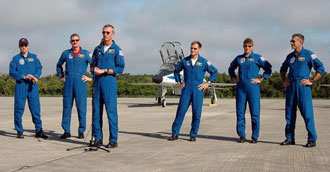
The
Atlantis crew gathers on the runway of the Shuttle Landing Facility in Florida Saturday after arriving in NASA T-38 jets. NASA.
|
Shuttle
Atlantis readies for next ISS mission
Spaceflightnow.com
news article, 3 Sep 2006. Go to Link.
After delays, NASA has restarted the shuttle Atlantis' countdown for a
Wednesday blastoff on a long-awaited mission to continue the space station's
assembly.
Atlantis and its six-person crew will deliver a $372 million set of solar
arrays to the International Space Station.
The Boeing-designed payload features two new solar arrays and a massive
rotary joint that will permit the giant panels to slowly turn like a giant
waterwheel to track the sun as the station circles the globe once every 90
minutes. |
________________________________________________________________________________________
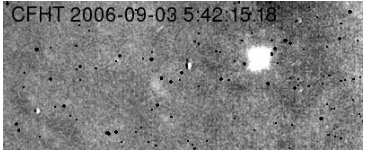
SMART-1's impact photographed by the Canada-France-Hawaii Telescope / 2006. See GIF animation at SpaceWeather.com.
|
SMART-1
went crashing into the moon
From an ESA
press release dated 3 Sep. 2006. Full
article.
At 07h42 SA time, 3 September 2006, a small flash illuminated the surface of
the Moon as the European Space Agency's SMART-1 spacecraft impacted onto the
lunar soil, in the Lake of Excellence region. The planned impact concluded a
successful mission that, in addition to testing innovative space technology,
had been conducting a thorough scientific exploration of the Moon for about a
year and a half.
The explosion was too faint for most backyard telescopes, but professional
observatories did witness the impact, when the satellite collided with the
moon at 7 200km/h. |
2. Astronomy news from around the world |
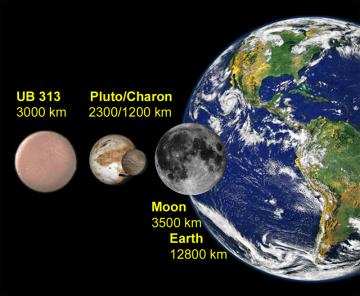
Comparative chart of Pluto and other solar system bodies. The recently
discovered UB 313 was one of the Kuiperbelt objects which gave way to the
planet definition controversy. Because a Kuiperbelt object (including Pluto)
"hasn't cleared the neighbourhood of debris around its orbit", it cannot
be called a planet. Some of them qualify for the term "dwarf
planet".
Image credit: Max Planck
Institute for Radio Astronomy
|
Pluto
now known as a "Dwarf Planet"
Based on IAU news
release of 24 Aug 2006. Full article.
In the past few years you frequently heard astronomers claiming they have
"discovered the 10th planet". One after the other, discoveries of
"planet nr. 10" came rolling in...
Pluto forms part of a huge asteroid belt somewhat behind the orbit of Neptune. Thousands and thousands of large space rocks orbit the sun just like the planets
do. This area is called the "Kuiperbelt". It is something we did
not learn in school and which was not standard in text books.
Astronomers have found over 1,000 Kuiperbelt objects since 1992 (Newsweek 4
Sept. 2006). Some of them are larger than Pluto and probably also round.
Suddenly some structure was necessary to the whole definition of what a
planet is!
At its General Assembly in August 2006, the governing astronomical body of
the world (International Astronomical Union) came up with a definition of a
"planet" and unfortunately Pluto did not meet the criteria. It does
however, meet the definition of a "dwarf planet", together with a
few other dwarfs already discovered.
It has now become more important than ever to teach children about the great
Kuiperbelt and what lies beyond. It will help broaden our perspective of the
scale of the solar system, which is much larger than we came to realize.
Pluto will be seen as a symbol of our need to better understand the size and
origins of our solar system. |
________________________________________________________________________________________
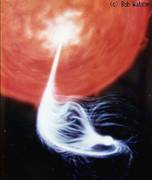
Artist Bob Watson's concept of a 'polar binary' - the white dwarf star below
sucking in the gas from the larger star.
|
New
Press Release from the Southern African Large Telescope
Extracts from
SALT press release dated 16 August 2006. Read full
article.
The Southern African Large Telescope (SALT) released its first public research results on 16 August 2006, giving new
insight into an exotic pair of stars closely orbiting one another.
Researchers used a strength of the SALT design which is rare among large
telescopes: the ability to take 'snapshots' of stars in very quick succession
in order to study the rapidly changing properties of compact stars,
especially as they pull in gas from their companions or surroundings.
The gravitational field of a compact star commonly pulls in gas from a
companion star - the radiation (especially X-ray) emitted as this happens is
one of the indirect ways scientists use to detect black holes. It is also the
way that mass builds up on some compact stars until supernova explosions blow
them apart, leading to 'Type Ia' supernovae recently used to show that the
expansion of the universe is speeding up.
In a polar binary like the one SALT studied, the 'white dwarf' star also has
a very strong magnetic field, which strongly influences how the hot gases
from its relatively ordinary companion reach the white dwarf's surface. |
________________________________________________________________________________________
Other news:
Stardust@home
You can help to search
for space dust! If your computer is connected, you can assist in scouring
through NASA's
Stardust space mission data: http://www.universetoday.com/2006/08/01/help-look-for-space-dust/
Space
Agency for South Africa
The South African
government has approved plans to set up the country's own Space Agency.
This comes as
SA is preparing to launch its second satellite into space. http://www.southafrica.info/ess_info/sa_glance/scitech/saspaceagency.htm
3. Interesting Space Facts |
________________________________________________________________________________________
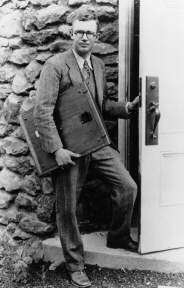
|
Tribute to Clyde Tombaugh: the discoverer of Pluto
Clyde
Tombaugh (1906 – 1997) was born in
Illinois
in the
USA
.
As a child he became interested in astronomy through his uncle. His father
even took up a second job to pay for the materials of a telescope that Clyde built himself. He made drawings of the planets and sent it to Lowell Observatory:
astronomer VM Slipher then offered him a position as junior observer.
He partook in a program to find the elusive “Planet X”. It called for the
photographing of a small piece of the night sky every evening... He
would then compare the photos to see if any of the dots appeared out of line,
compared to the previous photos taken of the same area. After 10 months
of arduous work, his patience paid off and he was awarded with the discovery
of the planet Pluto. It was announced on March 13, 1930.
Clyde discovered Pluto without even having a university degree. In his
spare time he did however, study science and obtained a doctor’s degree later
on. It is said that he was a very interesting person to be around
with and had a colorful personality.
An article on Clyde
Tombaugh on the internet: http://www.icstars.com/HTML/icstars/graphics/clyde.ht
Picture
at left: Clyde Tombaugh at Lowell Observatory (source).
|
4. The Solar System: Mercury |
In this issue we start with a
12-part series on the Solar System. We begin with the Sun and will then
move on to the planets.
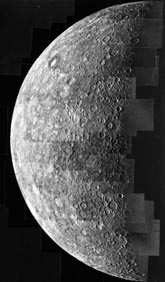
Mercury from space (JPL/NASA)
|
Now
the Smallest of them all: the Planet Mercury
Mercury
is the nearest planet to the Sun and has an eccentric elliptical orbit taking
it as close as 47 million km and as far as 70 million km. It is also the
fastest planet travelling around the Sun at a speed of 50 km/s! How would you
enjoy a flight from Bloemfontein to Kimberley in just over 3 seconds?
Because Mercury is so close to the Sun, daytime temperatures can reach
staggering heights of over 400 °C! During the night however,
temperatures can drop to minus 183 °C. The planet has virtually no atmosphere
to retain accumulated warmth. It is a small, rocky and barren planet, similar
in many respects to our Moon. Mercury too has thousands of impact craters
littering its very old surface. There are also no plate tectonics on
Mercury. Only one American satellite (Mariner 10) has ever visited the
planet, with 3 fly-by's in 1974 and 1975 (Mariner 10). Mercury is the second
densest planet, surpassed only by Earth.
The MESSENGER space probe is on
its way to Mercury, but will only arrive there in 2011.
Source
and more Mercury information: http://www.nineplanets.org/mercury.html
|
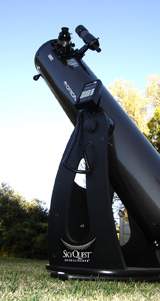
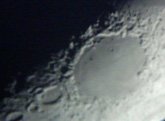
|
Planets
- September
2006
Mercury is visible in the evening sky from the end of the 2nd week.
Venus is visible in the morning sky until mid-month.
Earth is visible 365 days of the year, mornings and evenings. That is
if you are living on it!
Mars is only visible during the first week of the month in the
evenings.
Jupiter shines bright in the evening sky, for the whole month. Look in
the west.
Saturn is visible in the morning sky.
Constellations
and stars - evenings of September 2006
To the North: Lyra (the Harp), with the bright star Vega is clearly
visible to the north, setting in the west later at night. Trailing Lyra is
the exquisite constellation of Cygnus, the Swan, with its many telescope
objects. Pegasus, the flying horse, is rising in the east.
Mid-sky: Ophiuchus, the Serpent holder, is overhead and to the west.
Aquila, the Eagle, follows shortly after. Capricornus, the Goat, is an easy
target for beginners as it forms a huge "triangle" in the sky.
To the South: Pisces Austrinus, the Southern Fish, with its bright
star Fomalhaut, is visible to the south-east. Close by is Grus (the Crane
bird) and the constellation of Phoenix is rising.
Deep sky Objects
- September 2006
Look for M57
with an 8 inch and larger telescope in Lyra. Similarly, find M27 - the
Dumbbell nebula, in Vulpecula - a large fuzzy planetary. Sweep through
Ophiuchus with your finder to see how many globular star clusters you can
locate. Observe NGC 55 and NGC 253, two large galaxies, in Sculptor.
Use a binocular to scan the Milky Way region and Discover! the
night sky on your own...
Recommended: a telescope with 6 to 8 inch aperture and up. Unsure
where to get high-quality telescopes at a reasonable price? Contact SpaceTides to point you in the
right direction.
Other night sky
events
- Full Moon on 7 September 2006. New Moon on 22 September 2006.
- Partial lunar eclipse on 7 September 2006. Annular solar eclipse on 22
September 2006 - Bloemfontein can expect a 48% coverage.
Please consult the Sky Guide Africa South for detailed events and info. |
6. Amateur Astronomers' Corner |
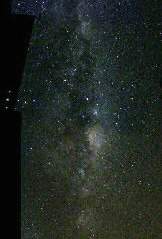
|
So
what's all this fuzziness about!?
Scene 1: On the
first night, John X sits in front of his computer and see the Hubble picture
of the Dumbbell planetary nebula. John X cannot believe the utter beauty and
eye-popping esthetics he has just witnessed... Suddenly he almost feels a
more content and fulfilled person, but he needs to see this thing for
himself. Scene 2: On the second night our dear Jonathan goes to an open
evening organised by the local amateur astronomy club. The operator points it
to M27 and cries "Wow, absolutely stunning! The seeing is SO good this
evening". John cannot wait to look through the 10 inch. He casts his eye
upon the eyepiece and suddenly, John stands utterly anti-amazed at the faint
hairy fuzziness before him. He experiences the same feeling that a Hollywood
fan gets when he sees his favourite actress being arrested for drunk driving.
Surely you've come across this situation: how to fulfill the expectations
before an open-evening? Here's a few tips: i) Describe the object with
typical amateur astronomer exuberance before showing it to the crowd.
Focus on the "wow facts" - your enthusiasm will carry over to the
would-be amazee. Have your facts handy. ii) While focusing the object, tell
them how stunning it appears through the eyepiece! iii) After they had their
first look, show them the Hubble picture and let them look again. This is
true for especially nebulae, in order to clarify the structure and outline of
the object. iv) Let the emotional extrovert in the group have the first
look... v) Explain why they don't see colour and detail. vi) Enjoy the
sense of personal appreciation that only an amateur astronomer can have! |
7. Astronomy in Southern Africa |
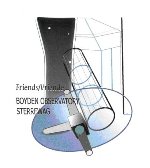
|
The
Friends of Boyden Observatory
The Friends of
Boyden was established in 1996 as an interest group involved in the public
outreach activities of Boyden Observatory. The Friends played a crucial role
in ensuring the future existence of one of South Africa's greatest
astronomical landmarks, Boyden Observatory.
Membership is open to any interested person. Members are kept up to date of
the latest public Boyden news & events and hold exclusive meetings where
astronomy and science talks are presented. The society also works
hand-in-hand with ASSA Bloemfontein Centre in assisting Boyden with certain
public open evenings. Go to the Friends' website at www.assabfn.co.za/friendsofboyden.
The 10 year anniversary of the Friends will be celebrated during a special
dinner event at Kopano Nokeng Country Lodge near Bloemfontein on 29 September
2006. More
information. |
__________________________________________________________________________________________

The ASSA Symposium affords astronomy enthusiasts the rare
opportunity to get
behind the scenes of SA astronomy. Base cost is R300 per person, with
an additional
R170 optional meals. You can also attend Friday's keynote session when Dr.
Adrian Tiplady (SKA/KAT),
Prof. Phil Chalres (SAAO) and Prof. David Block (WITS) will deliver exciting
and informative astronomy
talks from 11h00 to 15h00. The cost is R70 per person, which includes a lunch
together with the Symposium's participants. See the website at www.assabfn.co.za/symposium2006 or contact Gerrit Penning on 084 429 9080. |
Regulars:
__________________________________________________________________________________________
ASSA
national web news update
Subscribe
to the free ASSA web
update service. You receive a monthly email with links to news and
events in Southern African astronomy.
__________________________________________________________________________________________
Southern
Sky Talk Podcast
We are
constantly bombarded with reading material from all directions. Now you can listen to what's up
in then Southern African sky by simply clicking on the Southern Sky Talk podcast
link: brought to you
by psychohistorian.org.
Listen to the latest podcast and stand a chance to Win a special Hubble DVD!
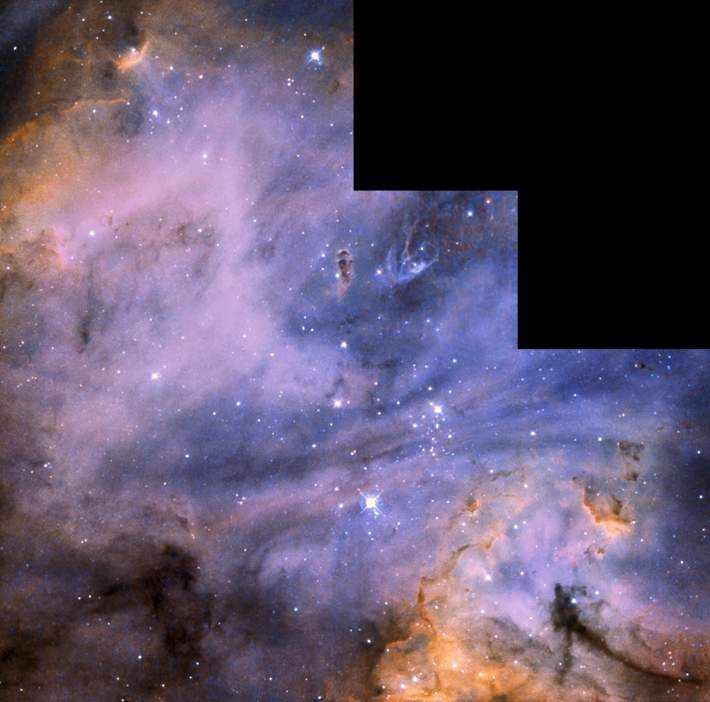
A Hubble Space Telescope
photo of an active star forming region in the Large Magellanic Cloud, a
satellite galaxy of our Milky Way galaxy. This specific region is called N
180B, and contains some of the brightest star clusters ever discovered. Some
of the hottest stars here can be a million times brighter than our own Sun.
These stars vent out powerful stellar winds that clear out nearby material
and cause interstellar gas to ionize and glow. From UniverseToday.com.
Image credit: NASA/ESA/STScI/AURA.
|
_____________________________________________________________________________________________________________________
SpaceTides is a free internet e-zine for persons interested in expanding
their general knowledge of astronomy and spaceflight.
The e-zine originates from the City of Bloemfontein in South Africa and is compiled us a service to the public by ASSA Bloemfontein Centre
as part of their educational outreach activities. Website: www.assabfn.co.za.
SpaceTides contains links to various other third party sites on the
internet, not always connected to SpaceTides. The persons and entities
responsible
for compiling SpaceTides will not be held responsible for the content or
information on these third party sites or any damage of any kind incurred
from
downloading, opening, or viewing anything from/through these sites.
Subscribe to SpaceTides by sending an e-mail to spacetides@assabfn.co.za with the word
"Subscribe" in the subject line.
If you
would like to Unsubscribe from SpaceTides, send an e-mail to spacetides@assabfn.co.za with the word
"Unsubscribe" in the subject line.
_______________________________________________________________________________________________________________________
|



